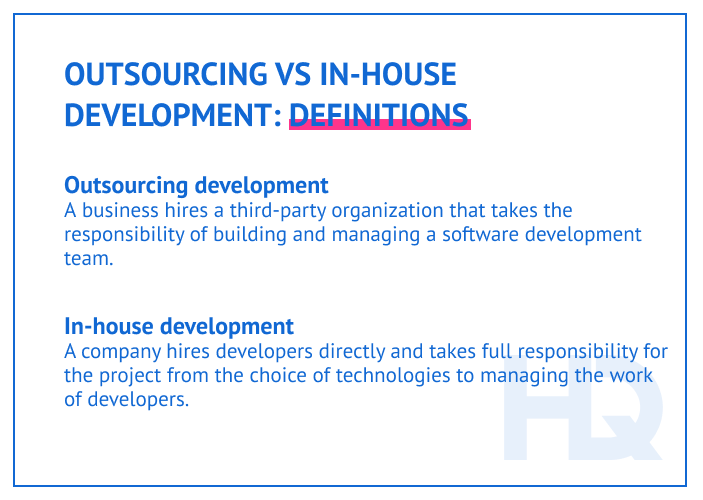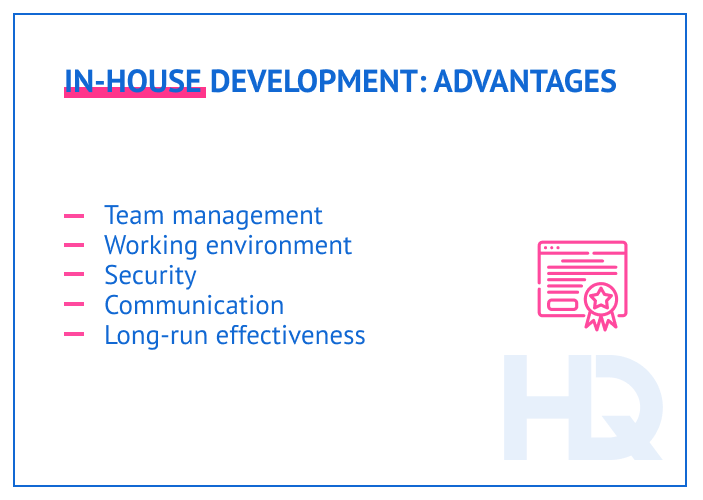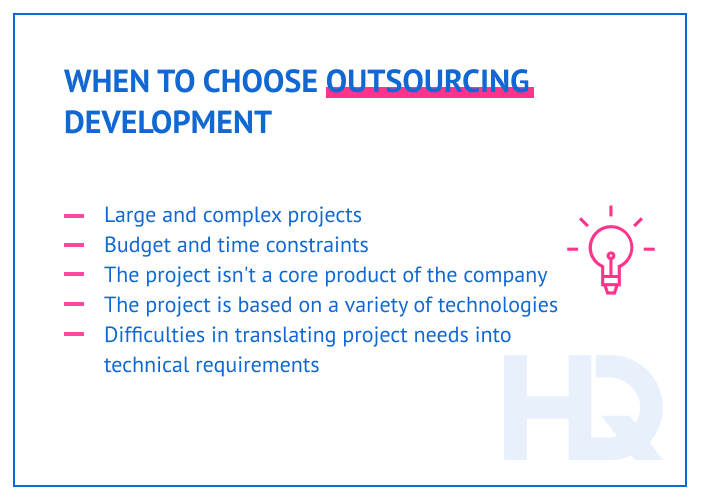Factors to consider while choosing the type of development team
Hiring an outsourcing team: pros and cons
In recent years, the IT outsourcing market has grown rapidly; in fact, it’s expected to reach $133.3 billion in 2025. This is happening because more and more companies are choosing to outsource development when they need to build a new software solution.
Another option, of course, is to hire an in-house development team. When a business intends to develop a software project, one of the most challenging decisions is the choice of in-house vs. outsourcing software development.
The decision will be influenced by many factors that we will discuss in this article, which can help you decide which type of development team is best for your company.
Factors to consider while choosing the type of development team
Hiring an outsourcing team: pros and cons
Let’s begin with understanding the differences between in-house and outsourcing development teams.
In-house developers are hired by a company directly and work as typical staff members. Under this model, a company takes full responsibility for the project, from choice of technologies to managing the work of developers. An in-house development model involves various costs related to selection of developers, provision of working space and benefits, vacation time, and so on.
The alternative is to outsource the project. In this case, the business takes the role of customer and hires a third-party organization to develop a solution. An outsourcing vendor takes responsibility for building and managing a software development team. This allows the customer to focus on primary business operations instead of becoming immersed in the details of development.

The most effective option for the outsourcing model is to hire a dedicated development team. Interaction with a dedicated team resembles working with an in-house team. A customer gets the software development professionals required for a specific project for long-term collaboration. Such a team is fully dedicated to the customer’s project and works only with it.
There’s no easy way to determine the winner in the in-house app development vs. outsourcing competition. Which is best depends on a variety of factors that companies need to consider before choosing what type of development team they will use. Below are some of the most significant:
But what are the features of each type of development team? Let’s start with in-house vs. outsourcing pros and cons.
According to statistics, around 60% of companies outsource at least part of their software development tasks. Such popularity is explained by all the features and benefits the outsourcing model provides.
Here are some of the numerous advantages of outsourcing development.

This is one of the main benefits that guided 70% of companies choosing in-house vs. outsourcing website development. The outsourcing model, based on a fixed hourly fee, usually results in lower development costs compared to an in-house team. In this way, a company can better predict the total project cost based on its duration.
Typically, hourly rates depend on the regions where developers are physically located. For example, developers from Eastern Europe have lower rates than developers from the US.
An outsourcing team can solve the problem of lack of necessary personnel in the company’s region by providing access to a talent pool of technical specialists.
In this way, a company can find developers with different experience and skill sets from all over the world. This is especially necessary when a project requires professionals who work with rare technologies.
Choosing outsourced development means an organization doesn’t have to worry about staff retention or finding a replacement if a developer quits, because this is the responsibility of the outsourcing vendor. This allows the company to remain confident that there are always specialists working on a project.
The terms of the dedicated team model allow a company to reconfigure a team structure at any stage of the project. Several specialists can be added to a development team during the project or removed from it when they have finished their work.
Also, the outsourcing model allows a company to mix working conditions and hire several specialists on a part-time basis while others will work full-time.
Outsourcing companies have a wide range of specialists with various skills, so they can create a team and start the development process very quickly, reducing time for recruitment and other HR activities.
In addition, the coordinated work of professionals with proven workflows speeds up time-to-market.
Seasoned outsourcing development team at your serviceHQSoftware has a team of skilled professionals ready to tackle the project. Let’s talk!
Julia Tuskal
Head of Sales
at HQSoftware
But despite all these advantages, outsourcing development also has several disadvantages.
Outsourcing teams are usually remote and distributed across several countries. So, there is a high chance that a company will hire specialists who don’t understand the cultural specifics or work ethos of the customer’s country. Also, difficulties may arise because of a difference in time zones and language of a company and the outsourcing team. However, in such cases, the outsourcing team takes on the responsibility of adapting to the customer, so the answer to the question of how to outsource overseas developers is not as complicated as it seems.
Lack of face-to-face communication makes it harder for a customer to control the outsourcing team than if it was right in the office. But outsourcing vendors now provide clients with a lot of opportunities for remote control, such as access to Jira, regular calls with team members, and timely project status updates. Also, a project manager provides the customer with comprehensive reports regularly, describing the progress of the development process.
Unfortunately, a customer can’t influence code quality directly. The only solution is to choose an outsourcing provider carefully, examining their portfolio, reviews, and previous experience.
Limited control over the development team increases the chance of disclosure of important customer data. To ensure data safety, it’s necessary to sign a non-disclosure agreement that guarantees the security of project code, IP, credentials, and other data. Moreover, many outsourcing companies work carefully to build a reputation as a trusted provider, so they create a safe environment for clients’ private information.
Most of the mentioned disadvantages can be eliminated if a company selects a reliable and trustworthy outsourcing partner, which guarantees smooth collaboration and high-quality team performance.
After figuring out the pros and cons of outsourcing development, let’s see how an in-house development team compares.
Of course, an in-house team also has its advantages and disadvantages.
Compared to outsourcing development, the benefits of the in-house model are closely associated with team interaction.

In-house software development allows a company to easily manage the development team. But it needs a strong management system or additional specialists who will control all development processes; otherwise, the work of the team won’t be efficient, possibly generating extra costs in time and money.
In-house specialists have a working environment that’s directly related to the company. It helps them better understand the specifics of a business and be more involved in the development process. This is especially important when developers have to work with specific equipment or systems that are used or produced by a company.
Strong control over the development team and working environment will allow a company to ensure that confidential information won’t be shared with third parties.
Usually, in-house developers are located in the same area or at least in the same country as a company. That makes them more attuned to the local culture and work practices. Also, face-to-face communication helps to avoid misunderstandings and encourages more analytics while project tasks are being completed.
An in-house team is cost-effective if a company needs developers not just for a particular task or project but also for long-term development. The company can train specialists in relation to its business needs, which will allow them to meet new challenges more quickly.
Hiring in-house developers usually means spending a lot of time and money on a project. Monetary costs include salaries, which vary from region to region, taxes, office rent, hardware, coverage for sick days, and other benefits. Time costs are associated with finding the right personnel, which can take up to several months, and onboarding. This will also lead to additional payment to the HR specialists who carry out these tasks.
There is a risk that developers with the necessary skills or experience will not be available in a company’s region. So, a company may have to make an effort to search for the right specialists, which will postpone the start of the development process for an indefinite time.
Since experienced developers are in demand on the market, IT engineers may change jobs quite often. If a developer quits in the middle of a project, the company will need to spend a lot of time finding another specialist. The new developer will have to understand the existing codebase before continuing. All this leads to downtime, which delays completion of the project.
Moreover, if a company doesn’t plan any future software projects, it will have to cut the entire team after it finishes working on the ongoing solution. This may have a negative impact on the company’s reputation.
To sum up, here’s a brief comparison of in-house development vs. outsourcing in the table below.
| Outsourcing development | In-house development | |
| Money costs | Flexible and cost-effective | Cost-effective only in the long run |
| Time costs | Low | High |
| Access to top talent | Not limited | Limited |
| Staff turnover | Low | High |
| Scalability | High | Low |
| Security | Medium risk | Low risk |
| Team management | Lack of team management by the company, but strong control by an outsourcing vendor | Strong team management by the company if it has a Project Manager or a Product Owner |
| Communication | Lack of face-to-face communication | Lots of face-to-face communication |
When deciding this question, businesses should rely on several markers.
A company might choose outsourcing in the following cases:

On the other hand, a company might choose an in-house team when:
Another option that some companies turn to is to mix in-house and outsourcing development. Most often this happens when a company has a certain staff of IT engineers and they need several specific developers. Outsourcing specialists may be needed if a company:
However, there is no definite guideline on what type of development is best for a particular solution. Every project is unique, and businesses should rely on their capabilities, requirements, limitations, and preferences while choosing in-house software development vs. outsourcing.
HQSoftware has been in the market for over 6 years and has developed more than 450 projects for 300+ clients all over the world.
We strictly select our developers and encourage their professional growth to offer reliable teams for all our clients. Our specialists have 4 years’ average employee tenure and are ready to provide their expertise to create high-quality solutions.
Also, we handle both common and more specific technologies and programming languages. So, we are ready to provide professionals for different project requirements.
Do you need to develop a software project or do you just have a project idea, but don’t know where to start? Feel free to contact us and get a personal consultation.

Head of Production
To ensure the outstanding quality of HQSoftware’s solutions and services, I took the position of Head of Production and manager of the Quality Assurance department. Turn to me with any questions regarding our tech expertise.
We are open to seeing your business needs and determining the best solution. Complete this form, and receive a free personalized proposal from your dedicated manager.

Sergei Vardomatski
Founder